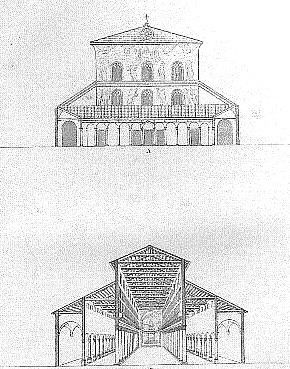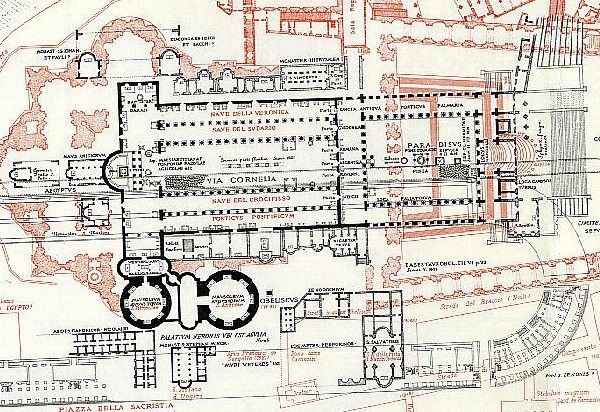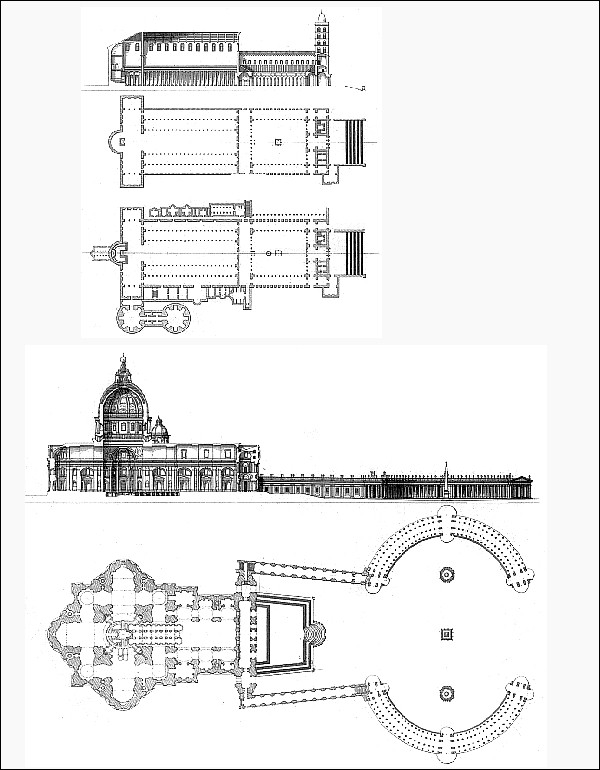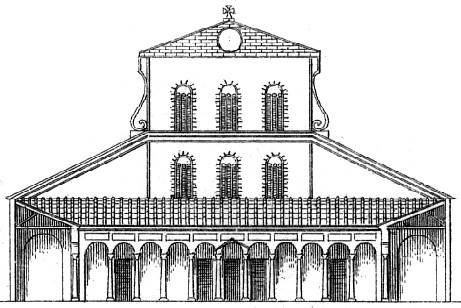Sometime between 313 and 319, construction of the Basilica Apostolorum, the Basilica of Saint Lawrence, the Basilica of Saint Peter (in Vaticano), and the Basilica of Saints Marcellinus and Peter begins. The mausoleum planned for Constantine, but subsequently housing the tomb of Helena, is attached to the Basilica of Saints Marcellinus and Peter, which is within the fundus Laurentus, Helena's Roman estate.

San Pietro in Vaticano (elevation, section).
| |

chronology of San Pietro in Vaticano
64:
Saint Peter suffers martyrdom and is buried on the Vatican hill.
c. 200:
The presbyter Caius, as quoted in Eusebius' Ecclesiastical History (303-324), points polemically to the tropaia in Rome of Saints Peter and Paul on the Vatican and the Ostian Road respectively.
317-318:
Coin found inside sarcophagus in mausoleum of Trebellena Flacilla below south transcept, proves intactness of cemetery at that time.
319-322:
An inscription, now in the ex-Lateran Museum and possibly of fourth century date, is generally interpreted as referring to an interruption of twenty-eight years in the annual sacrifices offered to the Great Mother in the Phygianum sanctuary, presumably located near the south end of Maderno's facade of New St. Peter's and thus south of the atrium of the old church. Concomitantly a gap occurs between 319 and 350 in a series of dedicatory inscriptions referring to these sacrifices and found, though not in situ, mostly in the excavation for Maderno's facade, others in the Borgo and as far as Castel S. Angelo. Hence a date shortly before 350 is suggested as ending this interruption. The break in services has been linked to the disturbance caused by the construction of Old St. Peter's nearby, and a beginning date between 319 and 322 for work on the church has been proposed.
319-324:
Constantine, in the pontificate of Sylvester I, 314-336, builds a basilica for Saint Peter, suppossedly enclosing his tomb with bronze plaques; above he sets up porphyry pilasters and vine scroll columns brought from Greece, causes the apse vault to be covered with gold foil, and provides for the church a precious silver altar, a number of alter vessels, though few if compared with the Lateran, and lighting fixtures of gold and silver for the nave, but none in front of the altar, and for the north aisle (only this?)...
Autumn 324
or after:
Constantine endows S. Peter's with rich land holdings, all in the Eastern provinces, hence not in his gift before the defeat of Licinius, September 18-20, 324.
after 324 and before 329:
Constantine places a heavy gold cross, inscribed by himself and his mother Helena as donors of the church. CONSTANTINUS AUGUSTUS ET HELENA AGUSTA HANC DOMUN REGALEM SIMILI FULGORE CORRUSCANS AULA CIRCUMDAT
Richard Krautheimer, Corpus basilicarum Christianarum Romae: Le basiliche cristiane antichi di Roma (sec. IV-IX) (Cittá del Vaticano: Pontificio istituto di archeologia cristiana, 1937-).
| |

Development of St. Peter's from 319 to 1546 to 1667.
Seroux scale comparison

Façade of ancient basilica of St. Peter as built by Constantine.
Seroux
|



